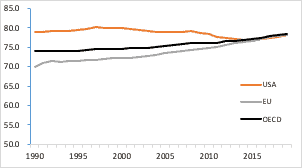Short-time work has prevented a drastic slump in employment in Europe. The United States has not been so lucky.

In March, ‘social distancing’ measures to stop the spread of Covid-19 led to the closure of schools, universities, restaurants, cafes, hotels, offices, factories and many other workplaces. During the first and second quarters of 2020, this resulted in an unprecedented slump in economic output.
Despite all the bad news, however, there remains a ray of hope: labour markets in Europe have so far largely weathered the crisis. The unemployment rate rose only slightly until recently, by 0.5 percentage points compared with pre-crisis levels (see table).
Economic effects of the coronavirus in 2020


Above all, this can be attributed to the strong welfare states in Europe—or, more precisely, to the widespread use of short-time work. Across the European Union, short-time working reached unprecedented levels in April, embracing over 42 million employees; the proportion of employees in short-time work reached over 40 per cent in Italy, France and Luxembourg. Germany recorded its highest figure to date in April, with six million short-time workers. Since then, the figures have been falling but they will probably remain high for some time to come.

A look at the United States shows just how lucky Europe is with its established systems of short-time working. Right at the beginning of the pandemic, US applications for unemployment benefits reached an unprecedented level. Despite moves to reopen the economy, the figures for late September show 12.6 million US workers unemployed and 25.2 million receiving unemployment benefits. The headline unemployment number was reduced by workers’ reluctance to search for work during a pandemic, while the number receiving benefits was increased by new benefits for freelances, young people entering the labour market, the lowest earners and others normally excluded from traditional unemployment insurance.
Tragedy avoidable
This tragic hike in unemployment was avoidable. In the euro area, output dropped by about 15 per cent in the first half of 2020, or about 5 per cent more than in the US. Yet the US unemployment rate peaked at 14.7 per cent in April, when the European rate was 7.4 per cent. The latest comparable figure shows the US rate at 8.4 per cent, still above the European average (8.1 per cent). And the headline unemployment rate in the US is likely to be underestimated—as evidenced by the large number of unemployment-benefit recipients.
The US does not lack an equivalent to European short-time working. Enshrined in federal legislation, short-time compensation (STC) schemes are administered by states and have names such as Work Sharing (New York, California), Shared Work (Connecticut, Washington), WorkShare (Massachusetts, Maine, Rhode Island) and Short-Time Compensation (Florida). Only 26 states have them, however, and coverage is low and falling.
At their peak in participation levels this past July only 400,000 workers were receiving STC benefits, and by late September the numbers had decreased to 195,000. While around 40 per cent of French workers and 20 per cent of German workers were enrolled in short-time work during the peak, only 0.25 per cent of US workers were participating in STC programmes.
Long-term consequences
High unemployment should worry Americans: even if the economic recovery were quick, the consequences could be long-term. Job losses affect earnings and may damage workers’ long-term mental and physical health. After the dot-com and 2008 crashes, many unemployed workers gave up job search and dropped out of the labour force.
The increasing average length of unemployment spells, structural changes in the economy, mass incarceration and restrictions on millions of undocumented migrants have all played a role in making US labour-force participation decline since 2000. It is now slightly below the average for the members of the Organisation for Economic Co-operation and Development and even EU countries (see figure).
Labour-force participation rates (%)

Of course, short-time work alone cannot bring the European economy out of the crisis, but it has proved a major stabilising factor in the pandemic. Others, such as the often greater protection against dismissal in Europe compared with the US, have contributed to the transatlantic differences in labour-market developments. The advantages of these labour-market institutions—often criticised in the past—are particularly evident today.
The US and other countries can however make broader use of short-time work without radically reforming all such institutions. Important steps would be better publicity for the (little-used) existing systems and a more attractive design for short-time work.
Maria Figueroa is director of labour and policy research at the Worker Institute in the Cornell University School of Industrial and Labor Relations; Ian Greer is director of the Ithaca Co-Lab there. Toralf Pusch is a senior researcher at the institute of Social and Economic Research (WSI) of the Hans Böckler Foundation.